ManyInterests
National Hazard
   
Posts: 837
Registered: 19-5-2019
Member Is Offline
|
|
Safety question dump
(I posted this in the short question/quick answer thread a while ago, but received no response. So I am posting it here)
So I have numerous questions regarding making nitrates and energetic materials. I just want to make very small batches of this stuff just as a proof
of concept and for fun. I am not experienced in making energetics except for black gunpowder and nitrocellulose, both of which I’ve made a few times
with great success (but no more than 10 grams of powder and 2 cotton balls at a time), and I wanted to try my hand at making small quantities of the
following: RDX, ETN, Picric acid, Ammonium Picrate, Nickel Hydrazine Nitrate, and (possibly) DDNP. I wanted to try to make PETN, but getting some of
the chemicals is a bigger headache than I care to go through at the moment.
I looked through the forums and some of the threads regarding many of these materials, and I still have quite a few questions to ask about these.
Primarily about safety (I believe in safety first, second, and third. Results last and I will sacrifice an optimal yield for added safety), and
secondly about making sure I have everything setup to make them successfully. I figured I’d make a big question dump in one go to get all the info I
need. Chemistry is something I got into recently and most of the stuff I have been doing is fairly safe (extracting chemicals from random store
products, crystalizations and recrystalizations, electrolysis, concentrating chemicals, etc, etc).
1: Sensitivity: I once thought about making TATP, but after seeing several videos on how insanely sensitive it is I decided to wisely heed the warning
you had on the wiki and steer as clear of all peroxide-based energetics. I value my fingers far too much to even dream of making that stuff.
But that being said, I do have other questions concerning sensitivity. I know RDX is considered super stable, so I am not worried about that. But what
about ETN? ETN, as I’ve read, is three times more sensitive than PETN. What does that mean exactly? Just how sensitive are we talking about here?
I mean if I wanted to make blasting cap and I put 1 gram or 0.75 grams as a booster and gently pressed it with a wooden dowel, would there be any
chance of detonation? What about fire in that regard? Can someone please tell me what ‘three times more sensitive’ means exactly.
Also I’ve seen some people make blasting caps and use small bits of cotton as a spacer between the booster, the primary, and the ignition mixture.
If I wanted to make a blasting cap using ETN, NHN, and black powder, and if I decided to use nitrocellulose in place of the regular cotton, would that
possibly cause problems? Or pose any danger of detonation? I’m just asking because I thought of doing that and I don’t want to end up doing
something bad. (I figure the nitrocellulose would give the blasting cap a bigger kick).
Regarding Picric acid. I know it should be kept stored in a wet state (as normally all explosives when not in use) but the wiki makes it look like it
is a lot more dangerous than others. Is ammonium picrate more or less stable?
Finally, about DDNP, I saw on the thread about it that its impact sensitivity is 1,5 Nm (150g from 1 meter or 1,5 kg from 10 cm). That means dropping
a 1.5 kilo weight from 10 cm will cause it to detonate? How dangerous is softly pressing it into a cap is? Redundant I know, but I really need to ask.
2: Nickel Nitrate:
I’ve read that nickel nitrate can be made by mixing nickel oxide in nitric acid. Would nickel metal suffice?
I don’t have nickel oxide or nickel chloride, but I do have a good supply of 99.6% pure nickel strips. I’ve seen videos where some guys let the
metal dissolve in a 65-68% HNO3 solution. Would 90+% fuming HNO3 also produce a similar result? The results would have a green solution. According to
the thread on NHN, the formula states to mix both the hydrazine sulfate and nickel nitrate in 95% ethanol before mixing. If the nickel nitrate is
already in a liquid state, would addition of ethanol be necessary at that point?
Also, how much nickel metal to acid is needed for an optimal result? How important is the addition of 30% hydrogen peroxide is to the solution (I’ve
seen videos were some use it and others don’t).
3: Fenton’s reagent.
I will likely need some Fenton’s reagent it to dispose of the picric acid/ammonium picrate I most likely will be making, but the exact proportion of
hydrogen peroxide to iron chloride is unclear to me. Can someone just give me a quick ratio?
4: Storage of nitric and sulfuric acids.
I know glass is often considered safe for storing even concentrated acids. But would liquor bottles also work for things like sulfuric acid and nitric
acid (either 68% or fuming)? I have one bottle I would like to use to store my concentrated sulfuric acid (I have a picture of it). It’s fairly
thick, but I don’t think it is borosilicate glass (doesn’t have to be since I will never heat it up).
On that note… once I use up a bottle of drain cleaner grade acid, are those bottles capable of holding up to reagent grade sulfuric acid? I really
can’t tell from a glance what type of plastic most bottles are, but I’m just asking for the sake of being complete and cautious above and beyond
(which you never can be with this hobby).
I don’t have any amber reagent bottles, so when storing very concentrated nitric acid, I would need to wrap the bottles in aluminum foil to prevent
any sunlight from degrading it. What about closing it? Would leaving it uncorked be a good idea to prevent nitrogen oxide buildup? Or is that a bad
idea as well?
Does 68% nitric acid need to be stored the same way as well?
I’m asking because chances are likely I’ll have some made, but not used, for a while. I’ll be going on vacation for a couple of months and
I’ll need to leave my reagents unattended. I need to make sure that nothing goes wrong while I’m gone.
I’ve attached a picture of the empty (and very clean and dry) rum bottle that I wish to store my sulfuric acid in.
Oh and for nitric acid, would a bottle like the one used for Triple Sec work for nitric acid? It's very dark tinted and the cap is 100% plastic (I
don't know what kind though).
https://www.lcbo.com/content/dam/lcbo/products/088328.jpg/jc...
[Edited on 1-6-2021 by ManyInterests]
[Edited on 1-6-2021 by ManyInterests]
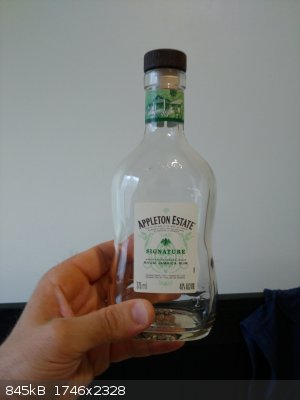
[Edited on 1-6-2021 by ManyInterests]
|
|
|
B(a)P
International Hazard
    
Posts: 1110
Registered: 29-9-2019
Member Is Offline
Mood: Festive
|
|
You have asked a huge number of questions here and I think the answer to quite a few of them are easily obtained from doing some reading. There are
some great texts available in the SM library on energetics that you should check out.
Working backwards -
Don't use cork to store nitric or sulfuric acid.
Yes the drain cleaner bottle is likely suitable to store higher purity acid. I note that proper storage bottles are not overly expensive.
You can make nickel nitrate starting from nickel metal and peroxide helps. It is quite a toxic compound so take care when working with it.
If you are interested in making energetics I would start with primary explosives not secondaries. There is a huge amount to learn about detonation
before you start working with explosive trains.
If you must then DDNP or NHN is not a terrible place to start. Make very small amounts, much less than one gram and don't store it. Then use a few
tens of micrograms to conduct tests and explore the sensitivity to various stimuli.
Before you embark on any of this I suggest a lot of reading on the subject. Make sure you understand the reactions and where things might go wrong
before you start. There are many threads on this forum coving much of what you have asked. Read read read, then proceed with caution. You also need to
check out the legal implications of making explosives in your area if you are unlicensed and unqualified.
|
|
|
ManyInterests
National Hazard
   
Posts: 837
Registered: 19-5-2019
Member Is Offline
|
|
Thanks for the information. I am aware of the safety risks and I have looked up quite of information on these. I did use the search engine, but
sometimes it didn't turn up with any of the answers I was looking for. I have done a lot of reading, but you can never really do enough. I actually
didn't look at the SM library. I looked through the wiki and the forums quite a bit, but since you mentioned it, I'll give it a reading.
Thanks for the information.
I do have one last question: But let's see if I find the answer before putting it here.
|
|
|
Texium
Administrator
       
Posts: 4508
Registered: 11-1-2014
Location: Salt Lake City
Member Is Offline
Mood: PhD candidate!
|
|
Glass liquor bottles with plastic lids are ok for storing acids. I have done that myself before in a pinch, and it didn't cause any problems. If the
stopper on your rum bottle is a synthetic rubber and not an actual cork, then that should be acceptable too. Just make sure you remove or cover the
label to make it absolutely clear that it is no longer liquor. Don't leave your nitric acid bottle unstoppered. It won't build up significant pressure
as long as you keep it in a cool, dark place. If you want to know the type of plastic used for a bottle, look for a recycling number on it. These
correspond to the type of plastic used. Most likely they're #2, which is high-density polyethylene.
|
|
|
ManyInterests
National Hazard
   
Posts: 837
Registered: 19-5-2019
Member Is Offline
|
|
Thank you for that answer. It definitely feels like a rubber of some kind and is certainly not cork (I know how cork looks and feels like, this is a
rubber stopper of some sort).
I will be buying some more bottles for storage and stuff. I took an inventory and I figured I could use more.
As for the sulfuric acid plastic bottles. I think I have one drain opener bottle that is almost empty. I can empty it out and purify the contents (and
clean the insides with a carbonate solution and let it dry) before filling it up with clean, reagent grade sulfuric acid. I think 800 ml of 98% will
last me a good long time. Sulfuric acid drain cleaner is fairly common where I live. However it does not have a recycling number. I will need to
search for the manufacturer's details online.
But about that question I had... might as well drop it here while I look for an answer: When making Hydrazine sulfate, after the sulfate is extracted
from the solution, what is the process of safely disposing of the leftover liquid?
|
|
|
XeonTheMGPony
International Hazard
    
Posts: 1636
Registered: 5-1-2016
Member Is Offline
Mood: No Mood
|
|
Wall mart and health food stores sell an array of containers that are suitable for a wide array of chemical storage, Just be sure to read some
comparability lists, and labeling above all ells clear labeling is a life saver.
( I had the joy of having my house getting a hoax police report and the clandestine labs division and 2 police stations take an un invited tour! BTY
Fun fact, Menthol, looks exactly like meth! the more you know!)
For added safety the most acutely toxic material is stored in a safe, such as Azide's, Cyanide's, Bromine ampules, Lead salts.
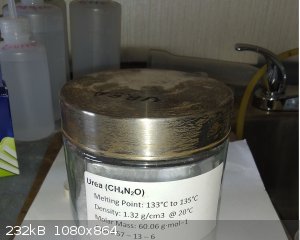 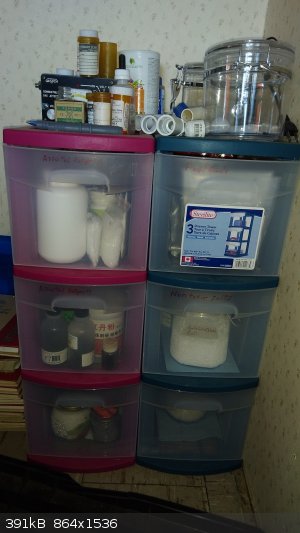 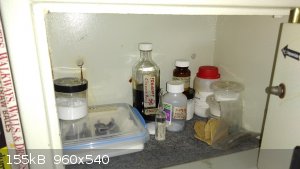  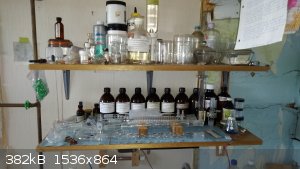
Attachment: Chemical corrotion compatibility chart of multiple materials.pdf (2.7MB)
This file has been downloaded 386 times
Attachment: Incompatible Chemical Groups.pdf (38kB)
This file has been downloaded 440 times
Attachment: PVC Compatability chemical list.pdf (779kB)
This file has been downloaded 321 times
Attachment: Metal chemical compatability chart.pdf (850kB)
This file has been downloaded 390 times
Attachment: HDPE chemical resistance chart.pdf (154kB)
This file has been downloaded 316 times
Attachment: HDPE_Chemical_Compatibility_Resistance_Chart.pdf (108kB)
This file has been downloaded 307 times
Here is an example of how I do my lab and some ways to organize things as you get going.
[Edited on 1-6-2021 by XeonTheMGPony]
|
|
|
ManyInterests
National Hazard
   
Posts: 837
Registered: 19-5-2019
Member Is Offline
|
|
Thanks dude. I need to do some major organizing myself. I don't have that many chemicals. So far the only chemical that I have that has any special
storage requirement is sulfuric acid and Muratic acid (still in its original bottle). Other stuff include potassium nitrate, homemade food grade
Hydrogen peroxide (stored in a peroxide bottle, the only one I use for that purpose so I know what it is) and some left over potassium chlorate. Some
slightly contaminated ASA as well.
I'll be doing some major reorganizing to get everything up straight and organized. You got a sweet setup, dude.
Again, the bottles I have don't state any numbers on them. I don't want to make a mistake and end up with a major spill of a very corrosive acid. I am
pretty new to chemistry, but I am dead set on being as safe as possible. Results are optional, safety isn't.
Edit: After looking through those charts I figured that I will need a few glass bottles for nitric acid. I think that the drain opener would have to
be HDPE, otherwise they would not be able to resist the acid, even with the inhibitors. I'll have to test it out, or otherwise just be cautious and
just my erlenmeyer flasks and glass liquor bottles (and keep them uncorked and uncovered to prevent the metal corrosion) and be extra careful with
them.
[Edited on 1-6-2021 by ManyInterests]
|
|
|
XeonTheMGPony
International Hazard
    
Posts: 1636
Registered: 5-1-2016
Member Is Offline
Mood: No Mood
|
|
The Chromic Acid is in an old Vanilla flavoring bottle, as you noticed the label was removed, and clearly labeled as such.
Invest in good bottles and, making clear written labels with a good quality masking tape, as you gain chemicals find and print out the SDS for them,
and keep a book listing the chemicals. This keeps LEO happy if they ever interact with you.
But, for now, read those compatibility tables, pay attention to the notes, such as temps, pressures in the charts, what will work at room temp may not
work at hotter temps vice versa.
You can sort of make improvised Teflon liners from tape and substrate (Card board or plastic circle cut out)
Oh and your question on Fentons reagent:
Hydrogen peroxide is your active ingredient, the Iron Chloride/Sulphate is the catylest
So the more Iron catylest the faster it reacts, the less slower.
I use 35% Peroxide, about 30ml H2SO4, and a "dash" of Iron-II Sulphate and warming this was to ensure a nice steady controlled degradation of the
organic waste.
So sort of flavor to taste situation (Only do not literally taste it!)
[Edited on 1-6-2021 by XeonTheMGPony]
|
|
|
ManyInterests
National Hazard
   
Posts: 837
Registered: 19-5-2019
Member Is Offline
|
|
Yeah, I looked up some glass reagent bottles (After looking at those charts you gave, glass is still the best for my purposes. I know storing some
acids like hydrofluoric acid love to attack glass, but I have no interest in that at the moment).
I'll look into the teflon liners. That sounds very interesting.
|
|
|
B(a)P
International Hazard
    
Posts: 1110
Registered: 29-9-2019
Member Is Offline
Mood: Festive
|
|
Another question I had meant to answer was on the use of nitrocellulose in a detonator. While this is acceptable, if you intend to initiate your
detonator with a lit fuse then make sure the contents of the detonator is perfectly protected against sparks generated by the burning fuse for obvious
reasons.
|
|
|
ManyInterests
National Hazard
   
Posts: 837
Registered: 19-5-2019
Member Is Offline
|
|
Quote: Originally posted by B(a)P  | | Another question I had meant to answer was on the use of nitrocellulose in a detonator. While this is acceptable, if you intend to initiate your
detonator with a lit fuse then make sure the contents of the detonator is perfectly protected against sparks generated by the burning fuse for obvious
reasons. |
Thank you, If I do make one I plan on using the body of a ballpoint pen. The reason is that the body is strong enough to let pressure build up, it's
plastic so no sparks can happen (I will take all precautions against static electricity), and it's transparent, so I can see exactly how the thing
looks like on the inside.
As for setting it off. While I do plan on making some safety fuses with black powder and plastic wrap, I would prefer to make an electric match and
set it off using a remote control.
|
|
|
Belowzero
Hazard to Others
  
Posts: 173
Registered: 6-5-2020
Location: Member Is Offline
Member Is Offline
|
|
At first I was a bit daunted by the amount of questions packed into a single post, I suppose the term "dump" does justice 
| Quote: |
So I have numerous questions regarding making nitrates and energetic materials. I just want to make very small batches of this stuff just as a proof
of concept and for fun. I am not experienced in making energetics except for black gunpowder and nitrocellulose, both of which I’ve made a few times
with great success |
Instead of answering exact questions I decided to just respond in a more general way.
My first question is how old are you?
This is by no means offensive (or interested in actual digits) as I started experimenting with energetics at the age of ~18 and looking back now I
have some doubts about my methods and level of thinking which is kind of easy to say roughly 15 years later.
It takes some boldness and a bit of youthful bliss.
One of the things I appreciate and recognize how serious you are willing to take all this!
By no means a recommendation but I would definitely start with materials that are 'safe' to handle.
For example caps with silveracetelyde/silvernitrate + ETN or PETN and blackpowder.
Get comfortable with nitrations and see how far you can push it, I would recommend doing a controlled runaway reaction just to understand what can
happen, it can be scary As Hell especially with larger batches and in an environment not very tolerant of accidental detonation..
Having a large bucket of water nearby is a must!
Picking up a beaker with boiling acids, ready to explode is nerve wrecking and potentially the dumbest thing you ever did, having a way of doing this
at a distance is something to consider.
I experienced a couple of such events with NG, EGDN, PGDN, PETN and ETN.
Sometimes this happend because I was being sloppy and didnt cool properly or just went too fast with addition, sometimes for no clear reason...
A detonation is not very likely but is always lurking around the corner.
Having glass and hot acids flying at supersonic speeds in a closed environment is the stuff of nightmares!
Afterwards it's easy to judge and I consider myself lucky that I never had any real accidents.
This does not mean I wasn't being careless or didn't know the risks, it's easy to get caught up in the moment and simple choices can carry serious
consequences.
That said I would suggest to take things slowly and start small.
One such example is electric detonators, I too value the comfort and safety of flipping a switch at a safe distance but this also introduces a lot of
complexity.
What will you do when you flip it and nothing happens..?
(I used to attach a wire to my cap so I could pull it out at a safe distance, something to think about)
In some cases a fuse is simply more reliable.
Taking the process apart and focus on getting a damn good setup before planning anything serious.
One more thing, more of a legal issue, how are you going to explain walking around with a bunch of wire and a curious looking box 5 min after a crazy
loud bang with noone else around?
Just some input which I hope is helpful 
If this doesn't add anything valuable to the conversation just ignore it and carry on 
[Edited on 2-6-2021 by Belowzero]
|
|
|
ManyInterests
National Hazard
   
Posts: 837
Registered: 19-5-2019
Member Is Offline
|
|
Sorry for the delay, but I had to take a long delay from this. I'm always in the midst of a million things. But your response did make me think and
I'd like to reply.
The age thing... I'd rather keep that private. But I suppose there is one element related to that. I actually have had to deal with anxiety most of my
life and I found that doing something that some people might find dangerous (handling dangerous chemicals in this case) actually does work for me long
term. I consider a big portion of this to be conquering anxiety.
Of course this doesn't mean being stupid. Hence why I am doing absolutely everything to ensure all safety precautions are taken.
| Quote: |
Get comfortable with nitrations and see how far you can push it, I would recommend doing a controlled runaway reaction just to understand what can
happen, it can be scary As Hell especially with larger batches and in an environment not very tolerant of accidental detonation..
Having a large bucket of water nearby is a must!
Picking up a beaker with boiling acids, ready to explode is nerve wrecking and potentially the dumbest thing you ever did, having a way of doing this
at a distance is something to consider.
I experienced a couple of such events with NG, EGDN, PGDN, PETN and ETN.
Sometimes this happend because I was being sloppy and didnt cool properly or just went too fast with addition, sometimes for no clear reason...
A detonation is not very likely but is always lurking around the corner.
Having glass and hot acids flying at supersonic speeds in a closed environment is the stuff of nightmares!
Afterwards it's easy to judge and I consider myself lucky that I never had any real accidents.
This does not mean I wasn't being careless or didn't know the risks, it's easy to get caught up in the moment and simple choices can carry serious
consequences.
|
Yeah, this is something that is always on my mind as well. I did look up intentional runaway tests and I actually plan on doing one to make sure I
know how to handle it calmly and correctly if the situation was to arise. All my nitrations so far have been done on an itty bitty scale and will
remain so. I have no interest in manufacturing anything beyond a few grams of something at a time. And I always keep an excess of the chemicals I need
to dispose of them correctly (hence why I have plenty of H2O2 at 30+%. I want to make sure I have all I need to get rid of any organic energetics I
make, as well as safely clean my glassware after making some).
You made NG? That's really ballsy. It's not something I plan on making at all. BTW, what is EGDN and PGDN? Never heard of those. I can't make PETN
because I have no access to formaldehyde at the moment, but ETN is doable.
| Quote: | That said I would suggest to take things slowly and start small.
One such example is electric detonators, I too value the comfort and safety of flipping a switch at a safe distance but this also introduces a lot of
complexity.
What will you do when you flip it and nothing happens..?
(I used to attach a wire to my cap so I could pull it out at a safe distance, something to think about)
In some cases a fuse is simply more reliable.
Taking the process apart and focus on getting a damn good setup before planning anything serious. |
I can actually authoritatively answer that one! My username isn't Manyinterests for nothing. I'm reasonably experienced in electronics and electronics
repair (I fixed computers for a living for a while) and remote controlled switches are actually the easiest thing in the world. You don't need to make
anything. Remote control relay switches are available on Banggood and AliExpress and Amazon for next to nothing.
But to answer your question of 'What will you do when you flip it and nothing happens..?'
I'll actually list all possible issues that could happen and what to do. Starting from the actual charge all the way to the relay.
1: The electric match construction was faulty. I made many electric matches as practice and if something is up, it means that the copper wires were
not making firm contract with the nichrome wire. This can be solved during construction using a multimeter. After constructing the electric match, use
the multimeter to make sure you have a complete circuit from both wire leads and from each wire lead to the nichrome on the top. If the multimeter is
beeping merrily, you have a complete circuit.
If it happens in the field. Press the button a few times and wait. If nothing happens. Press the button to open the switch (This is why it is absolute
vital that you read the electronic guide on the device and practice with it extensively so you know what everything does. It isn't hard). Second step,
wait a bit, it might still happen. Thirdly after waiting and you've switched the relay to an off position. Walk up to your setup and remove the switch
battery first then the relay battery.
I use battery packs that use 9v snap-on connectors, this allows for easier battery management in my projects. In the case of making a remote switch
for setting off detonators, it also makes it safer as the device can be rendered safe faster and easier.
2: The connection from the detonator to the switch battery is faulty. If this is the case. Follow the steps above before approaching and then check
the connections. If they're faulty, secure them and try again.
3: The connection from the detonator to the relay is faulty. Same as step 2.
4: The switch battery's connection to the relay is faulty. Same as step 2.
5: The switch battery has a low battery charge, or insufficient voltage/current to set off the electric match. I find my electric matches need 3 volts
from D, C, or AA l batteries (for the AAs I sometimes need 3 batteries delivering 4.5 volts) is the bare minimum, and usually from alkaline batteries
instead of carbon zinc. 9v batteries work, but only the alkaline ones.
I prefer 9vs because they're small and usually enough. Just use a fresh energizer 9v and it'll work pretty much all the time as long as all the
connections are good.
6: The connection of the relay batteries are faulty. Same as step 2.
7: The battery charge is too low for the relay to switch correctly. Same as step 5.
And finally.
8: The relay module is broken or has some fault in it. Basically you will need to disconnect everything and get a new one.
Always wait a bit before approaching.
I've made several radio switch toys and gadgets before and I am very familiar with how they work.
| Quote: | | One more thing, more of a legal issue, how are you going to explain walking around with a bunch of wire and a curious looking box 5 min after a crazy
loud bang with noone else around? |
That's a good question. I originally planned on just driving to a very remote, secluded area where no one is around for a good distance and setting
off the stuff. But after seeing a video of a youtuber testing out a homemade detonator I figured I'd add another step, both for safety and legality.
Basically get a large 5 gallon bucket. Fill it half way with dirt, put the charge in, fill the rest in with dirt. Effectively burying the charge.
This will act as both a safety barrier as the dirt would absorb the blast, but also muffle the sound.
I only plan on setting off one charge. A singular proof of concept and proof to myself that I've 'done' it.
[Edited on 12-10-2021 by ManyInterests]
|
|
|
|